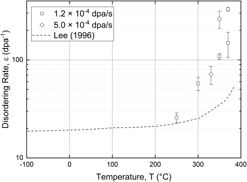Article contents
Unusual irradiation-induced disordering in Cu3Au near the critical temperature: An in situ study using electron diffraction
Published online by Cambridge University Press: 20 September 2018
Abstract

Atomic mixing by replacement collision sequences and other cascade effects is well known to create chemical disorder in irradiated alloys. Most studies of irradiation-induced disordering have focused on ex situ analysis of irradiated samples; however, fast in situ techniques are necessary to measure disordering at elevated temperatures without significant interference from concurrent re-ordering processes. In the present work, we use in situ electron diffraction with high speed data collection to measure the initial change in the long-range order parameter S with ion dose ϕ during 500 keV Ne+ irradiation of Cu3Au foils. The data reveal an unexpected and dramatic increase in the disordering rate as the critical order–disorder transition temperature TC is approached. Molecular dynamics simulations show that this increase is not due to temperature-dependent cascade mixing. We attribute the enhanced disordering, instead, to coupling between point defect fluxes and the chemical state of order.
- Type
- Article
- Information
- Copyright
- Copyright © Materials Research Society 2018
References
REFERENCES
- 1
- Cited by




